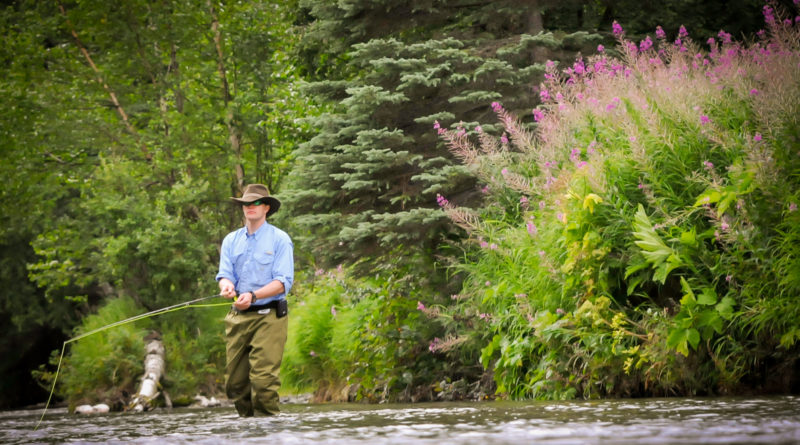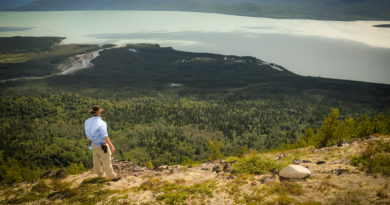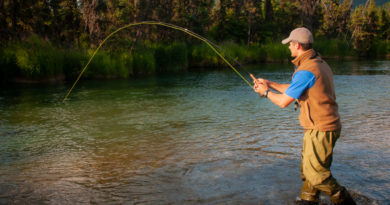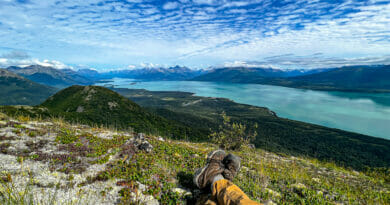Saltwater Fish in Alaska – The Top 5
Saltwater Fish in Alaska
Alaska is one of the most sought after locations for saltwater fishing. Most anyone who has ever gone deep sea fishing dreams of catching one of the prized saltwater fish in Alaska. Due to the abundance of food, the fish just grow bigger and fight harder. Only the fittest survive in the harsh conditions found in “the Last Frontier.” If you have it on the end of your line, it has the strength and endurance to have lived through many challenges before it grabbed your hook.
There are several ways you can experience an Alaska fishing excursion (read about them here), but no matter which one you choose, you will have the fishing experience of a lifetime. Some of these saltwater fish can be caught along the banks, rivers and lakes of Alaska. Others require the knowledge, transportation, and gear of a guide company. A successful Alaska fishing trip requires some foresight and planning.
Below you will find the top five saltwater fish to catch in Alaska. (For a list of my 5 favorite freshwater fish click here)
Chinook or King Salmon
Description of King Salmon
 The Chinook is also known as a King Salmon. Kings are the most sought after fish among Alaskan anglers. The average King ranges from 10-15 pounds but they can grow to be as large as 135 pounds! This makes the Chinook the largest of all the Pacific salmon. The king salmon is not as colorful as some other Alaskan salmon with a mostly monotone gray and black dull coloring with some areas of blue or green along the back. They have black pigment along the gum line. Some natives and residents call them the blackmouth salmon. Once the king begin their trip back to their spawning ground, their coloring begins to brighten and eventually turns into red or orange pigmentation. As they near spawning their back arches and their snout begins to curl.
The Chinook is also known as a King Salmon. Kings are the most sought after fish among Alaskan anglers. The average King ranges from 10-15 pounds but they can grow to be as large as 135 pounds! This makes the Chinook the largest of all the Pacific salmon. The king salmon is not as colorful as some other Alaskan salmon with a mostly monotone gray and black dull coloring with some areas of blue or green along the back. They have black pigment along the gum line. Some natives and residents call them the blackmouth salmon. Once the king begin their trip back to their spawning ground, their coloring begins to brighten and eventually turns into red or orange pigmentation. As they near spawning their back arches and their snout begins to curl.
Chinook begin their life cycle where they are spawned and spend one year at their home base. After the year, they begin their migration to the saltwater of the Pacific and live between 1 and 5 years before returning to their homeland to spawn. After spawning, all Chinook die completing their life cycle. Therefore, a king salmon lives between 2-7 years.
A few of the king salmon travel as far as 2,000 miles on their journey to the ocean. The journey back home occurs once per year in Alaska between the months of May and July. These are the best times to fish for king salmon, particularly along the Kenai Peninsula and areas around Kenai, Homer and Seward.
How to Fish for King Salmon
Chinook live almost all over Alaska, except for the extreme northern parts of the state. Some of the best King fishing is  along the Kenai Peninsula.
along the Kenai Peninsula.
The best time to fish for King Salmon is during the migratory spawning trip up the rivers dumping into the Pacific. These fish require a special tag that must be purchased to catch them. Being the largest of the Alaskan migratory fish, they are the most difficult to catch. They often stay as deep as possible in the rivers during the migration. That is usually the middle of the river, so it can be a challenge to catch large kings when bank fishing.
During low tides, brightly colored flies can be effective. Let the flies float past the fish at the pace the water is flowing in the river. During high tides, use large brightly colored lures or fresh herring or salmon roe. These can be fished with a bobber. Chinook hit bait very lightly so watch and feel closely before setting the hook.
Pacific Halibut
Description of the Halibut
 One of the most sought after fish for eating is the Halibut. The white sweet flavorful meat makes for an amazing Alaskan meal after a long day of fishing. Halibut must be fished offshore, therefore, a fishing charter is required to go after these huge flat bottom feeders.
One of the most sought after fish for eating is the Halibut. The white sweet flavorful meat makes for an amazing Alaskan meal after a long day of fishing. Halibut must be fished offshore, therefore, a fishing charter is required to go after these huge flat bottom feeders.
Halibut is a strange fish in that it is a flatfish. The body is flattened laterally and the fish swims sideways. Both eyeballs are on the same side of the body. Almost every halibut has eyes on the right side of the body.
The top of the body is very dark and splotchy to camouflage the fish with the bottom of the ocean. The bottom of the fish is usually white. Halibut can grow as large as 8 feet in length and weigh up to 500 pounds. Halibut can live up to 55 years.
How to Fish for Halibut
Pacific halibut are only found offshore along the continental shelf. They live along the coast of most of Alaska except for the extreme northern shore. Halibut prefer deep waters. A fishing charter will be necessary to successfully fish for halibut, therefore, this is an expensive fish to go after. Bank fishing for halibut is pretty much a waste of your precious Alaska vacation hours.
extreme northern shore. Halibut prefer deep waters. A fishing charter will be necessary to successfully fish for halibut, therefore, this is an expensive fish to go after. Bank fishing for halibut is pretty much a waste of your precious Alaska vacation hours.
Halibut generally like to hang out at depths of about 40-80 feet and they stay on the bottom of the ocean. Squid, mackerel heads and artificial plastic fish are good baits for halibut. These will be provided with your charter service. Fish deep!
Halibut harvested in the morning hours are seen daily at the docks of port towns in Alaska. Hanging the halibut and bleeding it helps the fish have a better flavor when cooked. If you are not up to chartering a boat, it is fun to just go and see the large halibut hanging from hanging hooks along the marinas of Seward, Homer and other places along the Alaskan coast.
Red or Sockeye Salmon
Description of Sockeye Salmon
 The Sockeye Salmon, also known as the Red Salmon is the most economically important salmon species in Alaska. It is marketed throughout the world for it’s firm red meat. It is usually the species you order at restaurants or buy at the grocery store. Sockeye are like the other species of salmon in that they spawn in the lakes of Alaska, stay one to three years and then make their way to the ocean for 1-3 years before returning to their original spawning ground to give birth to the next generation and die.
The Sockeye Salmon, also known as the Red Salmon is the most economically important salmon species in Alaska. It is marketed throughout the world for it’s firm red meat. It is usually the species you order at restaurants or buy at the grocery store. Sockeye are like the other species of salmon in that they spawn in the lakes of Alaska, stay one to three years and then make their way to the ocean for 1-3 years before returning to their original spawning ground to give birth to the next generation and die.
How to Fish for Sockeye Salmon

Sockeye begin their migratory journey back to their spawning ground in June and by the first week of August most of the migration is complete. At the end of the cycle, the salmon are rotting from the inside out and are a very bright red color with green heads that are deteriorating. The head of the salmon at the end of the spawning cycle deforms. The best flavor of the sockeye is just before or during the spawning. Therefore, July is the best month to catch these awesome saltwater fish in alaska.

They can be located in rivers, streams and lake that feed into the Pacific in south and southwest Alaska. The Kenai River and places along the Kenai Peninsula are good accessible locations to fish for sockeye. Seward, Homer, Anchorage and areas around there are easy to get to and provide great opportunities to catch reds. Soldotna River Walk, in Soldotna offers a great spot if you just want to fish from the bank.
My favorite spot to fish for sockeye if you want to access remote Alaska is along Lake Clark and Lake Clark National Park. The Kijik river is teeming with sockeye during the month of July. However, plane access is required, so you will have to charter a flight to fish this area.
While the fish are migrating, the best way to catch them is on spinner bait or spoons. Use brightly colored or silver bait to catch their attention. You can also use a fly-fishing rod and use flies that would resemble the insects found in the region you are fishing. Be ready for a fun fight as you try to out-power the fish who have been conditioned by their very difficult journey to their spawning grounds.
Humpies or Pink Salmon
Description of a Pink Salmon
 Pink Salmon (image by Earl Steele) are also known as humpies due to the male’s arched back and curved snout as they enter their spawning ground. Prior to their homeward return, however, they look similar to the sockeye with more muted coloration. This species of salmon are the smallest of all the Pacific salmon. Pinks are, however, the most populated. They range between 3.5 to 5 pounds. The average size of a humpy is 18″ long.
Pink Salmon (image by Earl Steele) are also known as humpies due to the male’s arched back and curved snout as they enter their spawning ground. Prior to their homeward return, however, they look similar to the sockeye with more muted coloration. This species of salmon are the smallest of all the Pacific salmon. Pinks are, however, the most populated. They range between 3.5 to 5 pounds. The average size of a humpy is 18″ long.
As with the previous salmon discussed, pinks are born in freshwater, make their way to the Pacific to live the majority of their lives and then return to the place they were born to spawn the next generation. Pinks are the only species of salmon that do not spend time in the freshwater before making their journey to the ocean. Virtually as soon as they are born, they make their migratory journey to the Pacific. Pinks stay in the ocean for a short 18 months before journeying back to their spawning ground.
Next to sockeye, pinks are the most important economical fish for Alaska. They often get canned and smoked and are sold throughout the world. Pink salmon have a bit lower oil content than the other species of salmon. They are best to eat when caught in the ocean or early on in the migration cycle.
How to Fish for Pink Salmon
Because of their abundance and smaller size, pink salmon are the easiest species to catch and land. They will feed off of a  huge variety of baits including spinners, spoons and flies. Pinks tend to furiously go after a presentation of bait and they are easy to hook. This is the best species of salmon if you are fishing with children. And it’s the fish that is easiest to catch shore fishing along river mouths in the Pacific. The Kenai River, Seward Harbor, the Homer Spit, and Ship Creek in Anchorage are great easily accessible locations to fish for humpies.
huge variety of baits including spinners, spoons and flies. Pinks tend to furiously go after a presentation of bait and they are easy to hook. This is the best species of salmon if you are fishing with children. And it’s the fish that is easiest to catch shore fishing along river mouths in the Pacific. The Kenai River, Seward Harbor, the Homer Spit, and Ship Creek in Anchorage are great easily accessible locations to fish for humpies.
Pinks are unique in that they tend to spawn later in the season than the other salmon. Their spawning cycle can extend into mid-October. Some folks call pinks “autumn salmon.” This is an advantage to the anglers who want to avoid the very busy rivers during June and July, but are not as interested in landing the “big ones.”
Also, the pink salmon doesn’t travel as far inland to spawn. Since their life-cycle is only 2 years, they often spawn near the mouth of rivers that dump into the Pacific instead of making the long journey inland to a quiet lake. Pink Salmon range around the entire coastline of Alaska, but do not make their way inland very far.
Ling Cod
Description of Ling Cod
 The Ling Cod (picture provided by Cracker Jack Charters) is a popular fish to catch offshore in Alaska. It is also, by far, the ugliest fish on this list! Its name is deceptive in that it is really not a cod at all. The Ling Cod is a member of the Greenling family of fish. It can live up to 25 years and can reach weights as high as 50 pounds. It is a moderately popular fish to catch due to it’s aggressiveness and size.
The Ling Cod (picture provided by Cracker Jack Charters) is a popular fish to catch offshore in Alaska. It is also, by far, the ugliest fish on this list! Its name is deceptive in that it is really not a cod at all. The Ling Cod is a member of the Greenling family of fish. It can live up to 25 years and can reach weights as high as 50 pounds. It is a moderately popular fish to catch due to it’s aggressiveness and size.
The ling cod, as ugly as it is, makes for a good table fish providing white meat with a good texture. It also makes a great picture for your Alaskan vacation. Ling Cod are bottom feeders and do not travel inland, so a fishing charter is necessary to bag these huge creatures. Click here for more info about chartering.
How to Fish for Ling Cod
Ling Cod are found throughout the Pacific and have limits to what an angler can keep on a given day. These fish are protected more and can easily be over-harvested, so catch and release is generally suggested. What makes these fish so fun to go after is their aggressiveness. Ling Cod hit hard and fight hard. They will generally furiously strike anything they perceive as a threat.
Due to the nature and location of these fish, a charter service is required and can range from $299 per half day to as much as $5,000 for multi-day excursions. Click here to find out more.
Trolling near the bottom of the Pacific along and among rock piles or other reef structure is the best way to land these fish. Your guide will probably use navigation systems and depth finders to point you in the right direction. Artificial jigs are the bait of choice when trolling for these monsters. Needless to say, if you hook one, you are in for quite an adventurous fight as you try to land the big fish.
Make Fishing in Alaska Part of Your Vacation
These are my 5 favorite saltwater fish in Alaska. If you are taking a trip to Alaska, make sure to make fishing a part of your adventure. These 5 fish offer you the opportunity to guide yourself on day fishing trips on the lakes and rivers of Alaska or you can pay for a multi-day guided experience. Whichever path you choose, you will most definitely be on your way to turning an Alaska vacation into an epic adventure!
For More Information about Fish Laws or Licensing Click Here!





Pingback: Things to Do in Soldotna Alaska - Things to Do in Alaska
Pingback: Top 10 Things to Do in Juneau Alaska - Things to Do in Alaska